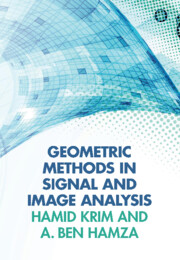5 - Geometric and differential topology of manifolds
Published online by Cambridge University Press: 05 July 2015
Summary
Geometric topology focuses primarily on the study of manifolds, which are the high-dimensional analog of surfaces. The restriction to manifolds, as opposed to general topological spaces, allows for a more geometric structure than in general topology, which is the study of the axiomatic properties of topological spaces. Differential topology, on the other hand, is the study of differentiable functions on differentiable manifolds. It is closely related to differential geometry and together they make up the geometric theory of differentiable manifolds. Unlike surfaces, manifolds in general need not lie in some ambient Euclidean space. Differentiable manifolds are used in almost all areas of engineering, ranging from signal/image processing and computer graphics to medical imaging and network optimization.
In this chapter, we introduce some of the basic terminology of geometric and differential topology. While appearing a bit more abstract than in the preceding chapters, our view of manifolds will be through the prism of applications, and will often invoke and exploit the local structure of a manifold which locally looks like a high-dimensional Euclidean space (i.e. a flat space which is often interpreted as a tangent space). Numerous books are devoted entirely to manifold theory (see [59–64] for complete treatments). With an applied goal in mind, we will keep our discussion on manifolds succinct, simple, and quite informal, by opting for a significant emphasis on applications of geometric and differential topology to imaging and computer graphics, while unveiling the relevant classical results on the theory of manifolds. We start by introducing the basic definitions of manifold theory in Section 5.1. In particular, we define and give illustrative examples of topological manifolds, smooth manifolds, smooth functions on manifolds, vector fields, pushforward and pullback, Whitney embedding theorem, connections on manifolds, and quotient topology. We then introduce in Section 5.2 the basic elements of Riemannian geometry, including Riemannian metric on a Riemannian manifold, the Laplace–Beltrami operator, and isometry between manifolds. In Section 5.3 we emphasize the relationship between the geometry and topology of a manifold through the topological invariants. We introduce the triangular mesh representation of manifolds.
Information
- Type
- Chapter
- Information
- Geometric Methods in Signal and Image Analysis , pp. 168 - 237Publisher: Cambridge University PressPrint publication year: 2015
